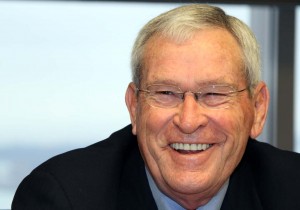
Why is this man smiling? Whitacre announces the GM IPO but hands the difficult work to his successor.
GM is taking the first crucial step to get the government out of what critics have dubbed Government Motors. Just moments before the final bell rang on Wall Street, the automaker announced it had filed registration papers with the Securities and Exchange Commission.
The maker plans to offer investors both common and preferred Class B shares as part of a gradual sell-off of the more than 350 million shares – equally to 60.8% of GM equity – now held by the U.S. Treasury. The company also plans to begin selling off the stake held by the Canadian and Ontario governments and will be listed on both the New York and Toronto Stock Exchanges following the IPO.
GM management has come under heavy pressure from the White House to stage the Initial Public Offering, the only way the White House can recover more than $40 billion invested by U.S. taxpayers following the maker’s 2009 bankruptcy. But company officials had, until today, refused to lock down a specific date for the offering – which many anticipated would be staged in advance of the upcoming mid-term Congressional elections.
But specific details of the IPO – including a specific date – remain in short supply. The automaker notably declined to say how much of the Treasury’s shares will be put on the block – or at what price. In recent months, there has been speculation that the maker would initially offer only a fraction of the government’s majority holdings, perhaps about 25%. But during a meeting with reporters during a conference in Traverse City, Michigan, earlier this month, GM CEO Ed Whitacre suggested taxpayers’ stake might be sold off in their entirety.
The initial, or strike, price also remains to be revealed. But to fully recover the government investment, the 358.7 million shares would have to be priced at more than $113 apiece (depending on the cost of underwriting the sale). That’s nearly 10 times more than the current trading price of Ford Motor Co stock.
The late announcement gives investors some time to think about GM’s announcement. But initial reaction is already mixed. “I think it’s premature. The economy is uncertain and I think they would have been better off waiting a year,” said Jim McTevia, a Detroit-based turnaround specialist.
Why the announcement of the IPO has taken so long hasn’t been revealed. Many observers had expected the news to break last week, immediately after GM announced its $1.3 billion second-quarter profit, a $14 billion turnaround from the same period the year before. One possible reason was working out the underwriting side.
The U.S. Treasury is reportedly forcing underwriters to accept a fee of less than 1% on the GM IPO, while the standard fee for an initial public offering runs 2% to 3%. There have been reports that Goldman Sachs had tried to undercut its competition by cutting the fee even further, perhaps to just 0.75%, a figure that would reduce costs by tens of millions of dollars. But the Treasury Dept. reportedly rejected the offer even while using it as leverage with other investment banks.
While the vast portion of the IPO will be used to help repay the Treasury, the sale of Class B stock will, GM said, provide cash for “general corporate purposes.” In the current global economy, the automaker is worried that it not face another potential cash shortfall.
Beyond getting the White House off its back, General Motors hopes to assuage critics, particularly among the Republican right wing, where some have gone so far as to call for a boycott of the carmaker’s products.
“We don’t like the label of ‘Government Motors,’” outgoing CEO Whitacre complained, earlier this month. “It turns customers off and it turns us off.”
While GM delayed the IPO filing, last week, the company did make one unexpected announcement, revealing that Whitacre will step down at the beginning of September. He will be replaced by board member Daniel Akerson. That development came as a bit of a surprise, even though the Texan had made it clear he wouldn’t stay on very long.
Observers say that news was designed to provide potential investors with a clear line of succession, but some observers say it also raises significant concerns – not only about Akerson’s ability to lead the long-troubled company but also about how it will impact GM’s turnaround efforts. The former telecomm executive will be the company’s fourth CEO in less than two years.
Joe Szczesny contributed to this report.
